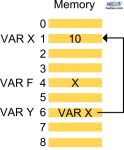
You're in troubles visiting an unknown city, having just discovered how unclear your map is.
Ask somebody the direction from where you're now, the Y position, to your X destination.
That's what you basically need.
More paths exist between Y and X, which can be fast but ugly, or long but panoramic: generally the way you reach X is not so important... and this is of worth for us too in our talk.
Indeed you only want to sign X and Y on your map.
Are you recognizing the web links surface behavior?
By starting from a web site you go to another one with a click, completely ignoring the path.
Classical example: from search engine results to a possible point of interest.
Yes, the point: you point your attention to it; the amount of solutions to get it is classifiable as pointer.
By talking about variables we said that the name chosen for them is a label to mask the address assigned to them in memory.
Pointers are variables pointing to other variables (even pointers again).
Picture above shows this: VAR Y is the var that actually masks the address 6 in memory, while VAR X the 1.
Simply VAR Y location contains VAR X value, but knowing how to threat it: value 6 is not an integer, but an address.
This means it can be only used to reach another memory location.
A possible scheme is: VAR Y ---> VAR X = 10 (integer).
We know VAR Y is a pointer, a variable which by nature must be characterized by the type of data it contains.
So a pointer is generally declared as a pointer to x-type.